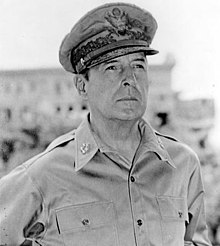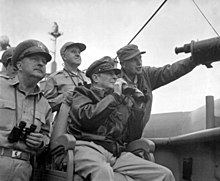Edward Almond
Edward Mallory "Ned" Almond (born December 12, 1892 in Luray , Page County , Virginia ; † June 11, 1979 in Anniston , Calhoun County , Alabama ) was an American officer in the US Army who served as a lieutenant general between 1950 and 1951 Commanding General of the X Corps deployed in the Korean War and responsible for the landing near Incheon called Operation Chromite . He was then from 1951 to 1952 in command of the US Army War College and most recently between 1952 and 1953 as commanding general of the Carlisle Barracks.
Life
Officer training, World War I and the interwar period
Edward Mallory Almond began training at the Virginia Military Institute (VMI) in Lexington after completing school in 1915. In November 1916 he was a lieutenant (Second Lieutenant) of the infantry in the US Army transferred and received in 1917 was promoted to lieutenant (First Lieutenant) . After the United States entered the First World War on April 6, 1917, he was transferred to the 4th Division ( 4th Division ) deployed in France in June 1918 , initially led by Major General John L. Hines and then by Major General George H. Cameron was commanded. There was carried out during his participation in the Meuse-Argonne Offensive (26 September to 11 November 1918) in October 1918 awarding the temporary rank of Major (Temporary Major) .
After his return, Almond was a lecturer in military science at the Marion Military Institute in Marion between 1919 and 1923 and taught there again from 1924 to 1928 after visiting the US Army Infantry School in Fort Benning and was promoted to major in August 1928 . After graduating from the Command and General Staff School (CGSS) at Fort Leavenworth in 1930, he was employed between 1930 and 1934 as the commander of a battalion of Philippine Scouts in the Philippines . On his return he was a graduate of the US Army War College (USAWC) in Carlisle and then from 1934 to 1938 a staff officer in the intelligence department of the General Staff of the Army. On September 1, 1938, he was appointed Lieutenant Colonel (Lieutenant Colonel) transported and then completed a course at the Naval War College (NWC) in Newport , which he finished 1,940th He then became Assistant Chief of Staff (G-3) of the VI in January . Corps ( VI Corps ) and got the temporary rank of Colonel (Temporary Colonel) of the Army of the United States on October 14, 1941 .
Second World War

After the attack on Pearl Harbor on December 7, 1941 and the entry of the United States into World War II on December 8, 1941, Edward Almond became Chief of Staff on January 12, 1942. Corps. He became Brigadier General of the Army of the United States on March 15, 1942 and then served between March and August 1942 as Assistant Commander of the 93rd Infantry Division ( 93rd Infantry Division ) stationed in Arizona , the so-called The Blue Helmets . Subsequently, he was in August 1942 commander of the 92nd Infantry Division under construction ( 92nd Infantry Division ) , the honorary name Buffalo Soldier wore. He received the rank of major general in the Army of the United States on September 23, 1942 and was transferred to Italy in August 1944 after completing the training of the 92nd Infantry Division , where he took part in the Italian campaign. After an attack on the Italian Riviera in the direction of Massa , his unit was in a several months' undecided battle (Seesaw Battle) against the German Wehrmacht along the Serchio Valley .
In April 1945, as part of Operation Grapeshot , a main advance led by the 442nd Infantry Regiment belonging to the 92nd Infantry Division was undertaken. In the course of this the capture of La Spezia and the flanking of the Gothic position succeeded , which opened the way to the Potal . At the time of the German surrender on May 2, 1945, the 92nd Infantry Division commanded by Almond held the coast north of Genuza . In 1945 he received the Army Distinguished Service Medal for the first time and, on July 10, 1945, the Silver Star twice .
Postwar and Korean War


After the war, Ned Almond returned in August 1945 to the USA and was between 17 September 1945 and June 1946 commander of the 2nd Infantry Division ( 2nd Infantry Division ) . There took place on November 1, 1945 his promotion to Colonel (Colonel) . In June 1946, he moved to the headquarters of General Douglas MacArthur after Tokyo , where he initially during the Occupation of Japan of Staff of the US ground forces in the Pacific region of assistive Chief (Assistant Chief of Staff, US Army Forces Pacific ) was. He was then Deputy Chief of Staff, US Army Forces Pacific between November 1946 and January 1947, and then from January 1947 to February 1949 Deputy Chief of Staff of the US Command Far East (Deputy Chief of Staff, Far East Command) . There he was promoted to major general (Major-General) on January 24, 1948 , with this promotion being dated back to September 17, 1944. As such, he was finally Chief of Staff of the US Command Far East (Deputy Chief of Staff, Far East Command) in February 1949 and held this post until August 26, 1950.
Shortly after the outbreak of the Korean War , Edward Almond was on August 26, 1950 Commanding General of the newly established X Corps ( X Corps ) , which consisted of two incomplete divisions and other mixed units. The X Corps mission was to carry out MacArthur's plan for Operation Chromite's landing at Incheon on the west coast of the Korean Peninsula . The landing, which was carried out by the units of the US Navy under Admiral Arthur Dewey Struble , took place on September 15, 1950. The X Corps quickly took Seoul and combined with the Eighth US Army ( Eighth US Army ) Lieutenant-General Walton Walker . Both units moved north to face a 120,000-strong unit of the Korean People's Army (KVA). In October 1950, the X. Corps was relocated by sea around the Korean Peninsula and landed on the east coast of North Korea in Wsannsan . After I Korea was incorporated into Almond's X Corps by the armed forces of South Korea , the unit advanced north and on November 21, 1950 reached the border with the People's Republic of China on Yalu . However, violent counter-attacks by the Chinese People's Liberation Army forced the troops of the United Nations (UN) to withdraw on November 25, 1950. On October 23, 1950, he was first awarded the Distinguished Service Cross for his services .
On December 11, 1950, the X Corps concentrated in the port of Hŭngnam and was disembarked from there to Busan in South Korea. It was a major operation involving the transfer of 105,000 soldiers with material for inclusion in the US Eighth Army. At the same time, 100,000 refugees were evacuated. After reaching the front in eastern central Korea again, the X Corps was a central component of the UN defense and participated in the gradual recapture and land reclamation as part of Operation Killer along the 38th parallel . On February 13, 1951, he became Lieutenant General in the Army of the United States, this promotion being dated back to February 12, 1952. On May 28, 1951, he was awarded the Distinguished Service Cross again. On July 15, 1951, he was replaced in the course of the dismissal of General MacArthur by President Truman as commanding general of the X. Corps by Lieutenant General Clovis E. Byers . On August 9, 1951, he was awarded the Army Distinguished Service Medal for the second time. For his services in the Korean War, he was also awarded the Legion of Merit and three times the Distinguished Flying Cross .
After his return to the United States, Ned Almond was from August 31, 1951 to June 12, 1952, in command of the US Army War College and, most recently, from June 12, 1952 to January 1, 1953, commanding general of the Carlisle Barracks in Carlisle . With his retirement on January 31, 1953, he was appointed Lieutenant General (Lieutenant General) promoted. He served as President of the Virginia Military Institute from 1961 to 1968.
From his marriage to Margaret Crook Almond the daughter Margaret Mallory Almond Fergusson and the son Edward Mallory Almond, Jr. emerged, who fell as captain and chief of the L Company of the 157th Infantry Regiment on March 19, 1945 in France. He himself was buried in Arlington National Cemetery after his death .
Web links
- Entry in The Generals of World War II
- Entry into Military Hall of Honor
- Entry in The Hall of Valor Project
- Edward Almond in the database of Find a Grave (English)
Awards
Selection of decorations, sorted based on the Order of Precedence of Military Awards :
-
 Distinguished Service Cross (2 ×)
Distinguished Service Cross (2 ×) -
 Army Distinguished Service Medal (x2)
Army Distinguished Service Medal (x2) -
 Silver Star (2 x)
Silver Star (2 x) -
 Legion of Merit
Legion of Merit
-
 Distinguished Flying Cross (3 x)
Distinguished Flying Cross (3 x) -
 Bronze Star (2 x)
Bronze Star (2 x) -
 Air Medal (16 x)
Air Medal (16 x)
| personal data | |
|---|---|
| SURNAME | Almond, Edward |
| ALTERNATIVE NAMES | Almond, Edward Mallory (full name); Ned (nickname) |
| BRIEF DESCRIPTION | American Lieutenant General in the US Army |
| DATE OF BIRTH | December 12, 1892 |
| PLACE OF BIRTH | Luray , Page County , Virginia , United States |
| DATE OF DEATH | June 11, 1979 |
| Place of death | Anniston , Calhoun County , United States |